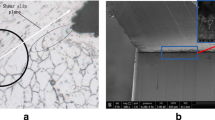Abstract
A model for the process of oxygen cutting of a metal plate is proposed which takes into account heating by external and internal heat sources, heat release from the cutting zone and reducing the thickness of the cutting geometry. The model was implemented numerically. It is shown that the model can describe different cutting modes: surface cutting, severing, and cutting in the kinetic and diffusion regimes. From the calculations results, the temperature field was constructed and the effect of the parameters on the thickness of the workpiece and the shape of the cutting edge was studied. The results are qualitatively consistent with experimental data.
Similar content being viewed by others
References
K. Chen and Y. L. Yao, “Interactive Effects of Reactivity and Melt Flow in Laser Machining,” High Temp. Mater. Proces., No. 4, 227–252 (2000).
A. Moarrefzadeh, “Numerical Simulation of Workpiece Thermal Profile in Plasma arc Cutting (PAC) Process,” WSEAS Trans. Appl. Theor. Mech. 6 (4), (2011).
F. A. Ardelean, “Study Regarding Modern Cutting Technologies,” Nonconvent. Technol. Rev., No. 1, (2011).
A. P. Amosov, I. P. Borovinskaya, and A. G. Merzhanov, Powder Technology of SHS Materials (Mashinostroenie, Moscow, 2007) [in Russian].
I. A. Antonov, Gas-Flame Treatment of Metals (Mashinostroenie, Moscow, 1976) [in Russian].
I. I. Sokolov, Gas Welding and Cutting of Metals: A Textbook (Vysshaya Shkola, Moscow, 1978) [in Russian].
G. L. Petrov and N. G. Burov, Technology and Equipment for Gas-Flame Treatment of Metals (Mashinostroenie, Leningrad, 1970) [in Russian].
Bo Zhou, Yu-jun Liu, and Soon-Keat Tan, “Efficient Simulation of Oxygen Cutting Using a Composite Heat Source Model,” Int. J. Heat Mass Transfer 57 (1), 304–411 (2013).
Kaijin Huang, Dawen Zeng, Changsheng Xie, and Desheng Xu, “Numerical Simulation of Three-Dimensional (3D) Unsteady State Temperature Field in Circumferential Laser Flame Cutting of Pipes,” J. Mater. Sci. Technol. 19 (Suppl. 1), 147–150 (2003).
Kai Chen, Lawrence Yao Y., and Vijay Modi, “Numerical Simulation of Oxidation Effects in the Laser Cutting Process,” Int. J. Adv. Manuf. Technol. 15, 835–842 (1999).
G. V. Ermolaev and O. B. Kovalev, “Simulation of Surface Profile Formation in Oxygen Laser Cutting of Mild Steel Due to Combustion Cycles,” J. Phys., D: Appl. Phys. 42, 1–10 (2009).
O. B. Kovalev, A. M. Orishich, V. M. Fomin, and V. B. Shulyat’ev, “Adjoint Problems of Mechanics of Continuous Media in Gas Laser Cutting of Metals,” Prikl. Mekh. Tekh. Fiz. 42 (6), 106–116 (2001). [J. Appl. Mech. Tech. Phys. 42 (6), 1014–1022 (2001).
I. E. Kil’ and A. G. Knyazeva, “Thermal Model of Oxygen Cutting of a Metal Plate,” in Mechanics of Aircraft: Proc. All-Russian Conference of Young Scientists, Tomsk State University, April, 2002 (Tomsk State University, Tomsk, 2002), pp. 32–34.
I. E. Kil’ and A. G. Knyazeva, “Numerical Study of a Thermal Model of Oxygen Cutting of a Metal Plate,” in Modeling of Processes in Synergetic Systems: Proc. Intern. Conf. Baikal Readings on Modeling Processes in Synergetic Systems, Maksimikha, Lake Baikal, 18–23 July 2002, Ulan-Ude (Tomsk State University, Tomsk, 2002), pp. 45–478.
M. A. Anisimova and A. G. Knyazeva, “Effect of the Chemical Heat Source on the Temperature Distribution during Oxygen Cutting of Metals,” in Advanced Materials in Engineering and Construction (PMTS-2013) Proceedings of the First All-Russian Scientific Conference of Young Scientists with International Participation, Tomsk, 21–25 October 2013, pp. 166–168.
D. A. Frank-Kamenetskii, Diffusion and Heat Transfer in Chemical Kinetics (Nauka, Moscow, 1987; Plenum, New York, 1969).
V. N. Vilyunov, Theory of Condensed-Material Ignition (Nauka, Novosibirsk, 1984) [in Russian].
A. G. Korotkikh, Thermal Conductivity of Materials: A Handbook (Tomsk Polytechnic University, Tomsk, 2011) [in Russian].
Z. Jurasz and K. Adamaszek, “Influence of Alloy Elements on Activation Energies of Valve Steels Oxidized at High-Temperatures,” METAL 2005. http://wwwmetal2014com/files/proceedings/metal 05 /papers/17pdf.
F. Kreith and W. Z. Black, Basic Heat Transfer (Harper and Row, Cambridge, 1980).
M. A. Mikheev and I. M. Mikheeva, Fundamentals of Heat Transfer (Energiya, Moscow, 1977) [in Russian].
N. I. Nikiforov, S. P. Neshumova, and I. A. Antonov, Handbook of Young Gas Welding and Cutting Operators: A Handbook for Technical Vocational Schools (Vysshaya Shkola, Moscow, 1990) [in Russian].
N. N. Rykalin, Calculations of Thermal Processes in Welding (Gos. Nauch. Tekh. Izd. Mashinostroit. Lit., Moscow, 1951) [in Russian].
Author information
Authors and Affiliations
Corresponding author
Additional information
Original Russian Text © M.A. Anisimova, A.G. Knyazeva.
Published in Fizika Goreniya i Vzryva, Vol. 52, No. 1, pp. 60–69, January–February, 2016.
Rights and permissions
About this article
Cite this article
Anisimova, M.A., Knyazeva, A.G. Model of oxygen cutting of a metal plate with chemical heat release. Combust Explos Shock Waves 52, 53–61 (2016). https://doi.org/10.1134/S001050821601007X
Received:
Revised:
Published:
Issue Date:
DOI: https://doi.org/10.1134/S001050821601007X




